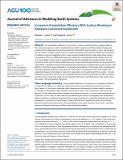Increase in Precipitation Efficiency With Surface Warming in Radiative‐Convective Equilibrium
Author(s)
Lutsko, Nicholas J.; Cronin, Timothy Wallace
DownloadPublished version (8.716Mb)
Publisher with Creative Commons License
Publisher with Creative Commons License
Creative Commons Attribution
Terms of use
Metadata
Show full item recordAbstract
The precipitation efficiency of convection (ε) plays an important role in simple models of the tropical atmosphere as well as in global climate models' projections of future climate changes, but remains poorly understood and poorly constrained. A particularly urgent question is how ε will change in warmer climates. To address these issues, this study investigates the precipitation efficiency in simulations of radiative-convective equilibrium with a cloud-resolving model forced by a wide range of sea surface temperatures (SSTs). Two different domains are considered: a small, doubly periodic domain, and a 2-D (x-z) “mock-Walker” domain with a sinusoidal SST profile that resembles the equatorial Pacific, and the sensitivities of the results to the microphysical scheme and to the horizontal resolution are also explored. It is found that ε generally increases with warming in the small domain simulations because of increases in the efficiency with which cloud condensate is converted into precipitation, with changes in the re-evaporation of falling precipitation playing a secondary role. This picture is complicated in the 2-D simulations by substantial changes in the degree of convective organization as the underlying SSTs are varied. ε is found to decrease as convection becomes more organized, because convective organization results in relatively more low clouds, which have small (≤0.1) precipitation efficiencies, and relatively less high clouds, which have larger (∼0.4) precipitation efficiencies.
Date issued
2018-11Department
Massachusetts Institute of Technology. Department of Earth, Atmospheric, and Planetary SciencesJournal
Journal of Advances in Modelling Earth Systems
Publisher
American Geophysical Union (AGU)
Citation
Lutsko, Nicholas J. and Timothy W. Cronin. "Increase in Precipitation Efficiency With Surface Warming in Radiative‐Convective Equilibrium." Journal of Advances in Modelling Earth Systems 10, 11 (November 2018): 2992–3010 © 2018 The Authors
Version: Final published version
ISSN
1942-2466